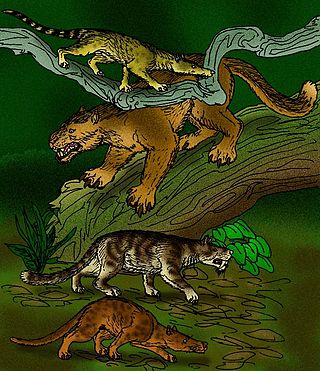
Creodonta is a former order of extinct carnivorous placental mammals that lived from the early Paleocene to the late Miocene epochs in North America, Europe, Asia and Africa. Originally thought to be a single group of animals ancestral to the modern Carnivora, this order is now usually considered a polyphyletic assemblage of two different groups, the Oxyaenids and the Hyenodonts, not a natural group. Oxyaenids are first known from the Palaeocene of North America, while hyaenodonts hail from the Palaeocene of Africa.

Viverravidae is an extinct monophyletic family of mammals from extinct superfamily Viverravoidea within the clade Carnivoramorpha, that lived from the early Palaeocene to the late Eocene in North America, Europe and Asia. They were once thought to be the earliest carnivorans and ancestral to extant ones, but now are placed outside the order Carnivora based on cranial morphology as relatives to extant carnivorans.

Miacis is an extinct genus of placental mammals from clade Carnivoraformes, that lived in North America from early to middle Eocene.

Paroodectes is an extinct genus of placental mammals from clade Carnivoraformes, that lived in Europe during middle Eocene.

Carnivoramorpha is a clade of placental mammals of clade Pan-Carnivora from mirorder Ferae, that includes the modern order Carnivora and its extinct stem-relatives.

Vulpavus is an extinct paraphyletic genus of placental mammals from clade Carnivoraformes, that lived in North America from early to middle Eocene.

Miocyon is an extinct genus of placental mammals from clade Carnivoraformes, that lived in North America from early to late Eocene.

Oodectes is an extinct paraphyletic genus of placental mammals from clade Carnivoraformes, that lived in North America from early to middle Eocene.

Palaearctonyx is an extinct genus of omnivorous placental mammals from clade Carnivoraformes, that lived in North America from early to middle Eocene.
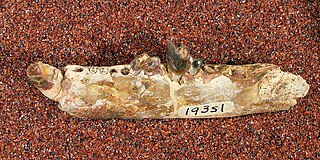
Uintacyon is an extinct paraphyletic genus of placental mammals from clade Carnivoraformes, that lived in North America from early to middle Eocene.
Xinyuictis is an extinct genus of placental mammals from clade Carnivoraformes, that lived in Asia from early to late Eocene.

Didymictis is an extinct genus of placental mammals from extinct subfamily Didymictinae within extinct family Viverravidae, that lived in North America and Europe from the late Paleocene to middle Eocene.
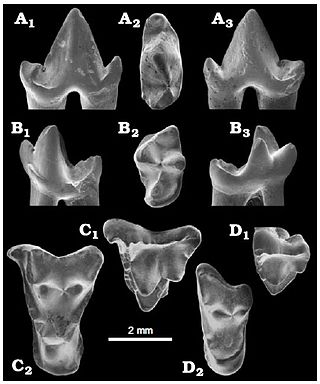
Gracilocyon is an extinct paraphyletic genus of placental mammals from clade Carnivoraformes, that lived in North America and Europe from late Paleocene to early Eocene.

Sinopa is an extinct genus of placental mammals from extinct family Sinopidae within extinct order Hyaenodonta, that lived in North America and Asia from the early to middle Eocene.
This paleomammalogy list records new fossil mammal taxa that were described during the year 2013, as well as notes other significant paleomammalogy discoveries and events which occurred during that year.
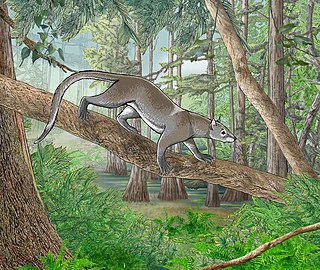
Dormaalocyon is an extinct genus of placental mammals from clade Carnivoraformes, that lived in Europe during early Eocene. Type species, Dormaalocyon latouri was discovered when fossils were unearthed in the village of Dormaal, near Zoutleeuw, in the Belgian province of Flemish Brabant.
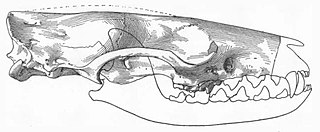
Viverravus is an extinct genus of placental mammals from extinct subfamily Viverravinae within extinct family Viverravidae, that lived in North America, Europe and Asia from the middle Paleocene to middle Eocene.

Carnivoraformes is a clade of placental mammals that includes the modern order Carnivora and its extinct stem-relatives.

Palaeonictinae is an extinct subfamily of placental mammals from extinct family Oxyaenidae, that lived from the late Paleocene to early Eocene of Europe and North America.
Boualitomidae is a family of extinct predatory mammals from extinct order Hyaenodonta. Fossil remains of these mammals are known from middle Paleocene to late Eocene deposits in Africa. Boualitomids had only three pairs of premolars in the lower dentition, lacking the first one.
















